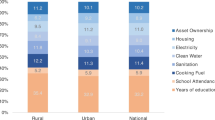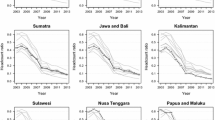Abstract
This paper uses the recent approach of multidimensional deprivation measures to provide a comprehensive and wide ranging assessment of changes to living standards in India during the period, 1992/93–2004/5. This covers the reforms and the immediate post reforms time periods. The study is the first to be based on the simultaneous use of two parallel data sets, namely the National Sample Survey (NSS) and National Family Health Survey (NFHS) data sets, covering proximate rounds and near identical time periods. The results allow a check of consistency on the picture of deprivation in India between these two data sets. The study is conducted both at regionally disaggregated levels and by socio economic groups. The deprivation dimensions range widely from the conventional expenditure dimensions to non-expenditure dimensions such as access to drinking water and clean fuel, to health dimensions such as child stunting and the mother’s BMI. The use of decomposable deprivation measures allows the identification of regions, socio economic groups and deprivation dimensions that are contributing more than others to total deprivation.

Similar content being viewed by others
Notes
These terms are used synonymously following their simultaneous use in the literature.
These are the individual states in India.
This is the decomposable poverty measure suggested by Foster, Greer and Thorbecke (1984).
See the NFHS webite, www.nfhsindia.org for further details.
A child (0–3 years) is considered “stunted” or “wasted” if that child’s z score of height for age and of weight for height is less than 2, respectively. This is consistent with the definition of child malnourishment adopted in the literature (see, for example, Svedberg (1990)).
For the purpose of these graphs, we have pooled the rural and urban data and treated the rural and urban areas of the state as separate points, giving us a scatter of 30 points for each data set.
Since the decline is much less rapid for the NSS, this suggests that the improvement in the deprivation occurs mainly because of the health based deprivation dimensions.
References
Atkinson, A. B. (1970). On the measurement of inequality. Journal of Economic Theory, 2, 244–263.
Bourguignon, F., & Chakravarty, S. (2003). The measurement of multidimensional poverty. Journal of Economic Inequality, 1, 25–49.
Chakravarty, S., & D’Ambrosio, C. (2006). The measurement of social exclusion. Review of Income and Wealth, 52(3), 377–398.
Chakravarty, S., & Majumder, A. (2005). Measuring human poverty: A generalized index and an application using basic dimensions of life and some anthropometric indicators. Journal of Human Development, 6(3), 275–299.
Foster, J. E., Greer, J., & Thorbecke, E. (1984). A class of decomposable poverty measures. Econometrica, 52, 761–766.
Hicks, D. (1997). The inequality-adjusted human development index: A constructive proposal. World Development, 25(8), 1283–1298.
Jayaraj, D., & Subramanian, S. (2010). A Chakravarty–D’Ambrosio view of multidimensional deprivation: some estimates for India. Economic and Political Weekly, XLV, 6, 53–65.
Klasen, S. (2000). Measuring poverty and deprivation in South Africa. Review of Income and Wealth, 46(1), 33–58.
Majumder, M., & Subramanian, S. (2001). Capability failure and group disparities: Some evidence from India for the 1980 s. Journal of Development Studies, 37(5), 104–140.
Mishra, A., & Ray, R. (2010). Multi dimensional deprivation in India during and after the reforms: Do the household expenditure and the family health surveys present consistent evidence? Discussion Paper 36/10 of Economics Department, Monash University, Australia.
Mishra, A., & Ray, R. (2011). Prices, inequality and poverty: Methodology and Indian evidence. Review of Income and Wealth. (forthcoming)
Sen, A. K. (1985). Commodities and capabilities. Amsterdam: North-Holland.
Svedberg, P. (1990). Under nutrition in Sub-Saharan Africa: Is there a gender bias? Journal of Development Studies, 26(3), 469–486.
Acknowledgments
The research for this paper was funded by an Australian Research Council Discovery Grant (DP0773489).
Author information
Authors and Affiliations
Corresponding author
Rights and permissions
About this article
Cite this article
Mishra, A., Ray, R. Multi-Dimensional Deprivation in India During and After the Reforms: Do the Household Expenditure and the Family Health Surveys Present Consistent Evidence?. Soc Indic Res 110, 791–818 (2013). https://doi.org/10.1007/s11205-011-9959-6
Accepted:
Published:
Issue Date:
DOI: https://doi.org/10.1007/s11205-011-9959-6




